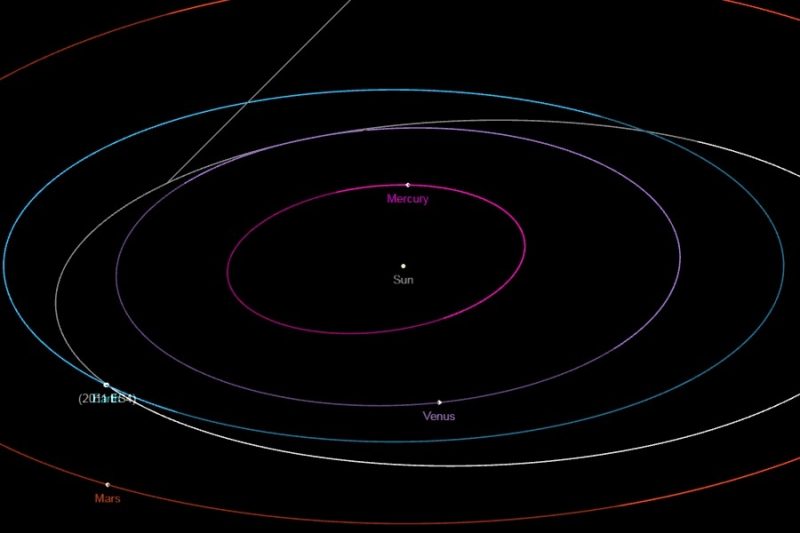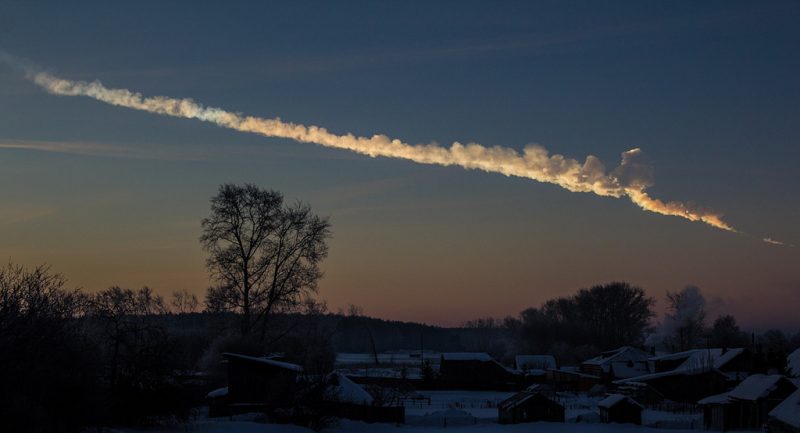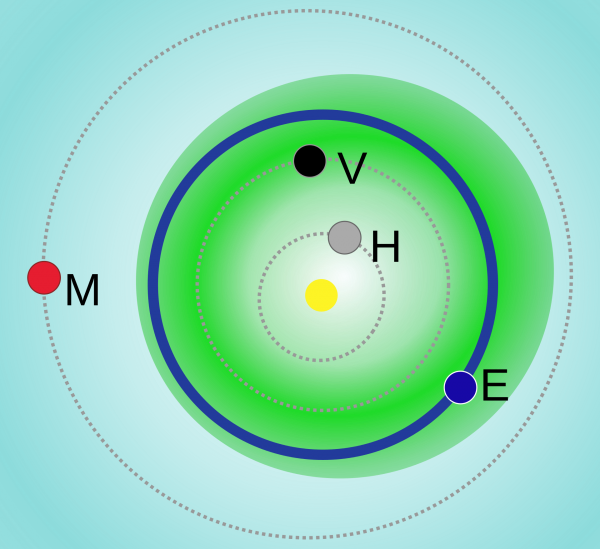
A healthy-sized chunk of space rock is expected to pass closer than the moon on September 1, 2020. There is uncertainty in its orbit, but scientists say it will not hit our planet. Asteroid 2011 ES4 is expected to pass at somewhere around 30% of the Earth-moon distance. But it might pass farther – far outside the moon’s orbit – as far as 3.4 lunar distances. Or it might pass closer, as close as 0.19 lunar distances. Why is there so much uncertainty? More about that below.
The asteroid should pass closest around 16:12 UTC on September 1 (12:12 p.m. EDT; translate UTC to your time).
The asteroid has an estimated diameter of 72 to 161 feet (22 to 49 meters). That’s in the range of the Chelyabinsk meteor – around 17 meters (55 feet) in diameter – which swept through Earth’s atmosphere above Russia in February 2013, generating an enormous shock wave that broke windows in six Russian cities and caused some 1,500 people to seek medical treatment, mostly from flying glass.

But back to asteroid 2011 ES4. The uncertainty about its orbit is due to the fact that observatories were able to track the space rock during only four days after it was detected on March 2, 2011, from the Mount Lemmon Survey in Arizona. After that, the asteroid became too faint to be observed.
Astronomers use an uncertainty scale from 0-9, in which 0 means the orbit is well known, and 9 means great uncertainty. Asteroid 2011 ES4 has an uncertainty of 7. The uncertainty not only means it may pass farther or closer than expected, but also may cause it to pass hours or even days earlier or later than expected.
Astronomer Lance Benner, an asteroid expert from NASA/JPL, told EarthSky:
Uncertainty indicates that it could miss Earth by 0.08 AU, which is much, much more than one Earth-moon distance. If that happens, and given that the moon is nearly full right now, then it’s possible that none of the surveys will find it during this flyby.
UPDATE: Asteroid 2011 ES4 was recovered or re-observed on September 5, 2020. It was a difficult detection as the Moon was nearly full. In fact, the new observations indicate the space rock was closest to Earth on September 2, 2020. The asteroid was passing at 3.8 lunar distances (farther than expected), but now the orbit is well known, and the space rock has been removed from the Sentry Risk Table.
Asteroid 2011 ES4 is classified as a Near-Earth Object (NEO). But it’s good to know that this Apollo-class asteroid is not classified as a Potentially Hazardous Asteroid. What’s the difference? A Potentially Hazardous Asteroid is defined as an object that passes relatively close to Earth, and also is large enough (more than 150 meters, about 500 feet, in diameter) to cause significant regional damage, were it to strike Earth.
Thus you may see that asteroid 2011 ES4 has the potential to come rather close. And it’s a healthy size, bigger, for example, than the tiny (truck-sized) asteroid that swept just 2,000 miles (3,000 km) from Earth on August 16, 2020. Yet – as asteroids go – asteroid 2011 ES4 is still relatively small, not large enough to cause significant damage upon impact (and it is not expected to get close enough to enter our atmosphere, much less impact).
So – to all of you worriers – you may all breathe easily now.

If an asteroid as big as 2011 ES4 were to hit our planet, it wouldn’t be big enough to cause a major impact, much less an extinction-level event. However, a space rock with an average size of 98 ft (30 meters) in diameter, like this one, could cause a huge shock wave if it enters our atmosphere.
Fortunately, even with the margin of error in calculations, asteroid 2011 ES4 should safely pass by Earth on September 1, 2020.
If asteroid 2011 ES4 is detected in the next few hours or days, it might at first be confused with a “new” asteroid, and get a temporary or provisional designation before models show it definitely has the same trajectory, indicating that it is in fact asteroid 2011 ES4 being “recovered” in our skies. If astronomers do spot it – and if new observations are able to be made – astronomers should be able to better define the space rock’s orbit.
We see lots of news about close passes of asteroids. But most of asteroid passes involve very small space rocks. We don’t have to worry, because if a small asteroid hits our atmosphere, most of it will disintegrate, and since Earth is around 70% covered by oceans, most events will occur over water, probably even unnoticed.
What about any big asteroid approaching Earth? Although there are many small asteroids whose orbit crosses the orbit of Earth, fortunately, there is no known big space rock with a dangerous orbit which poses a threat to our planet.
As part of nature, there will be, however, lots of other significant approaches in the future, including asteroid Apophis on April 13, 2029. That will be an exciting opportunity for scientists. And even for casual observers, the close approach of Apophis will be an amazing event, as the space rock may even be slightly visible to the unaided eye from some areas.
Bottom line: Asteroid 2011 ES4 is expected to pass at about 0.3 or 30% the Earth-moon distance on September 1, 2020. But it might pass farther, or as close as 0.19 lunar distances. The asteroid should pass closest around 16:12 UTC on September 1 (12:12 p.m. EDT; translate UTC to your time).











